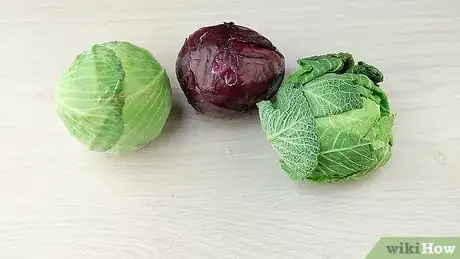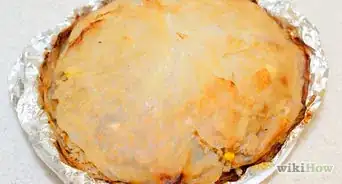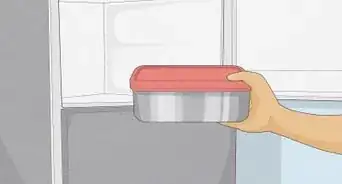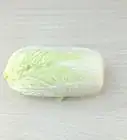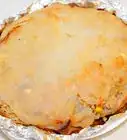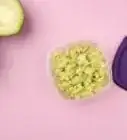This article was co-authored by wikiHow Staff. Our trained team of editors and researchers validate articles for accuracy and comprehensiveness. wikiHow's Content Management Team carefully monitors the work from our editorial staff to ensure that each article is backed by trusted research and meets our high quality standards.
There are 11 references cited in this article, which can be found at the bottom of the page.
The wikiHow Video Team also followed the article's instructions and verified that they work.
This article has been viewed 242,835 times.
Learn more...
While the core of a cabbage can be eaten once cooked, most cabbage recipes call for you to core the head of cabbage before preparing the dish. Doing so makes it easier to cut the rest of the cabbage, and it also reduces the overall cooking time in many instances. If you've never cored a cabbage, here are the steps you need to take.
Steps
Standard Way (Round Cabbage)
-
1Know which types of cabbage to use this method with. This method should be used with round heads of cabbage, the most common being green cabbage, red (or purple) cabbage, and savoy cabbage.
- Note that there are some similarities between this method and the standard method used for cutting long cabbages, but there are a few small difference, as well.
-
2Cut off the stem of the cabbage head. Use a sharp kitchen knife to trim off any portion of the stem that extends below the bottom of the cabbage head.[1]
- If you are using a wooden or plastic cutting board, stabilize it by placing a dry dish towel underneath. This prevents the board from slipping around as you cut the cabbage. It is not usually necessary if you have a non-slip cutting mat, though.[2]
Advertisement -
3Slice the cabbage in half lengthwise. Cut the cabbage in half from top to bottom, slicing it straight through the stem or core end.[3]
- Hold the cabbage steady with your non-dominant hand and cut with your dominant hand.
- Cut carefully so that you do not accidentally slip and cut yourself while working with the cabbage.
-
4Make another lengthwise cut in each half. Turn each half so that it sits cut-side down. Cut each half in half again, cutting through the core once more, essentially dividing the head into quarters.[4]
- Since the cut-side is flat, it will be easier to hold the cabbage still with that side facing the surface.
- Once you cut the cabbage into quarters, though, the quarters will need to be flipped over so that the cut-sides face up, thereby exposing the core.
-
5Cut a triangular piece out of the bottom of each wedge. With the cut sides facing up, you should be able to see the core at this time. Make an angled cut on either side of the core to remove it from each quarter.[5]
- At this point, you should also peel off any tough or wilted outer leaves.
- This is also the point in time at which you should rinse the cabbage under cool, running water.
-
6Prepare the remaining cabbage as desired. From this point on, the cabbage can be shredded, cut into smaller wedges, separated into layers, or used in a variety of other ways for a wide range of hot and cold recipes.[6]
Standard Way (Tall Cabbage)
-
1Know which types of cabbage to use this method with. This method should be used with long, narrow heads of cabbage. The most common type would be napa cabbage.
- Note that there are some similarities between this method and the standard method used for cutting round cabbages, but there are a few small difference, as well.
-
2Cut the cabbage in half lengthwise. Use a sharp knife to cut the cabbage head from top to bottom, cutting straight through the core end.[7]
- You will end up cutting the core and stem in half during this step.
- Note that you do not need to trim the stem before cutting the cabbage in half.
- Hold the cabbage steady with your non-dominant hand and cut with your dominant hand.
- Cut carefully so that you do not accidentally slip and cut yourself while working with the cabbage.
- Stabilize the cutting board by placing a dry dish towel underneath. This may not be necessary if you have a non-slip cutting mat, however.
-
3Slice out the core. Keep the cut sides facing up. The core should be fairly easy to spot. Make an angled slice around each side of the core. Cut straight through to the bottom so that you can lift the core out afterward.
- At this point, you should also peel off any wilted outer leaves.
- Rinse the cabbage under cool, running water to clean it, as well.
-
4Use the remaining cabbage as desired. From this point on, the cabbage can be shredded, cut into smaller wedges, separated into layers, or used in a variety of other ways for a wide range of hot and cold recipes.
Coring Whole Cabbage (Round Cabbage)
-
1Know what types of cabbage to use this method with. This method should be used with round cabbage varieties, including savoy cabbage, green cabbage, and red (purple) cabbage.[8]
- You could try this method with a long cabbage variety, like napa cabbage, but you may not have much success. Long varieties of cabbage tend to have looser leaves, and you may lose too many of the inner leaves while trying to remove the core via boiling, as called for in this method.
-
2Boil a large stockpot of water. Fill a stockpot 2/3 full with water. Bring it to a boil over medium-high heat on the stove.
- If you want to help add flavor to the cabbage, you can add up to 1 Tbsp (15 ml) of salt to the water after it reaches a boil.
-
3Remove any damaged leaves. Peel off any torn, damaged, or wilting leaves before proceeding to core the head of cabbage.
- Most of the outer leaves will drop off once you dunk the cabbage in the boiling water. Since the good leaves can be preserved, however, it is still advisable that you separate the bad leaves ahead of time.
-
4Trim the stem. Use a sharp kitchen knife to trim off any portion of the stem that extends below the bottom of the cabbage head.
- Hold the cabbage steady with your non-dominant hand and cut with your dominant hand.
-
5Stick a fork into the core. Apply firm pressure so that you can shove the prongs of a metal fork as deep into the center of the core as possible.
- Ideally, the fork will be inserted so far that the individual prongs will be just barely visible from the outside of the cabbage. A good portion of the fork needs to be stuck inside. To test whether or not enough has been inserted, try lifting the cabbage with nothing but the fork. If it does not drop off or show signs of doing so, you have inserted enough of the fork into the core.
-
6Cut around the core. Use a smooth knife to cut a circular incision around the core of the cabbage head.
- Hold the fork with your non-dominant hand and cut with your dominant hand.
- Cut carefully, especially as you turn the knife toward the hand holding the fork. Being careful can help prevent you from accidentally cutting yourself while working with the cabbage.
- If you want to skip the boiling part altogether, try cutting into the core at an angled circle, with the knife tip facing inward toward the center of the cabbage.
- If you plan to follow through with the boiling steps, however, cut a vertically straight circle all the way around the core.
-
7Dunk the cabbage into the boiling water. If you were unable to remove the core, dip the head of cabbage into the boiling water and let it cook for a few minutes, just until it begins to soften.[9]
- Work carefully to avoid burning yourself with the boiling water or the hot steam.
- After about 5 minutes, the outer leaves should start falling off. This is when you can remove the cabbage from the boiling water.
-
8Cut into the core at an angle. Use a narrow, smooth knife to cut into the circular incision, this time going in at an angle. The core should be easier to remove at this point now that it has been softened.
- The tip of the knife should point toward the center of the cabbage as you work around the core.
-
9Use the remaining cabbage as desired. Since this method is a little more involved and more difficult than the standard method, it is generally only used for recipes that require a whole head of cabbage, such as stuffed whole cabbage.[10]
- This method is also ideal when you want to cook the core whole, since the other methods require you to cut the core into sections before removing it.
Community Q&A
-
QuestionHow long should I boil cabbage for cabbage rolls?
 Community AnswerIt is a multi-step process. Boil cabbage for six to eight minutes, until the outer leaves become loose. Remove them from the water and peel off all loose leaves. Return the unpeeled cabbage to the water; repeat the process until all usable leaves are removed.
Community AnswerIt is a multi-step process. Boil cabbage for six to eight minutes, until the outer leaves become loose. Remove them from the water and peel off all loose leaves. Return the unpeeled cabbage to the water; repeat the process until all usable leaves are removed. -
QuestionHow do I core a cabbage?
 Community AnswerFollow the instructions listed in the article above.
Community AnswerFollow the instructions listed in the article above. -
QuestionWhy do some people put cabbage in the freezer?
 Community AnswerBecause vegetables go bad quickly in the refrigerator. This locks all the moisture, and for bacteria to spread, it needs moisture.
Community AnswerBecause vegetables go bad quickly in the refrigerator. This locks all the moisture, and for bacteria to spread, it needs moisture.
Things You'll Need
- Cutting board
- Kitchen towel
- Sharp kitchen knife
- Stockpot (optional)
- Metal fork (optional)
References
- ↑ http://cooklikeyourgrandmother.com/how-to-core-cabbage/
- ↑ https://startcooking.com/how-to-cut-cabbage
- ↑ https://www.finecooking.com/article/how-to-core-cabbage
- ↑ https://www.jessicagavin.com/how-to-cut-cabbage/
- ↑ https://www.fifteenspatulas.com/how-to-cut-cabbage/
- ↑ https://www.thekitchn.com/best-cabbage-recipes-227147
- ↑ https://www.youtube.com/watch?v=G508ZzInOhc
- ↑ https://startcooking.com/how-to-cut-cabbage
- ↑ https://www.food.com/recipe/stuffed-whole-cabbage-266033
About This Article
To core a cabbage, first, rinse the cabbage and remove any wilted or damaged leaves. Use a sharp kitchen knife to cut off any excess stem that is sticking out below the bottom of the head of cabbage. Set the cabbage on a cutting board and slice it in half lengthwise, from the top to the stem end. If the cabbage is round, cut the pieces in half again to make quarters. Then, make a diagonal cut from the base of each wedge to the middle to remove the stem and core. If the cabbage is a long type, such as a napa cabbage, set each half down with the cut side facing up, then make a triangular cut at the base of each half to remove the stem and core. Prepare the rest of the cabbage however you like. If you want to learn how to core a tall cabbage or how to keep the cabbage intact while you core it, keep reading the article!
